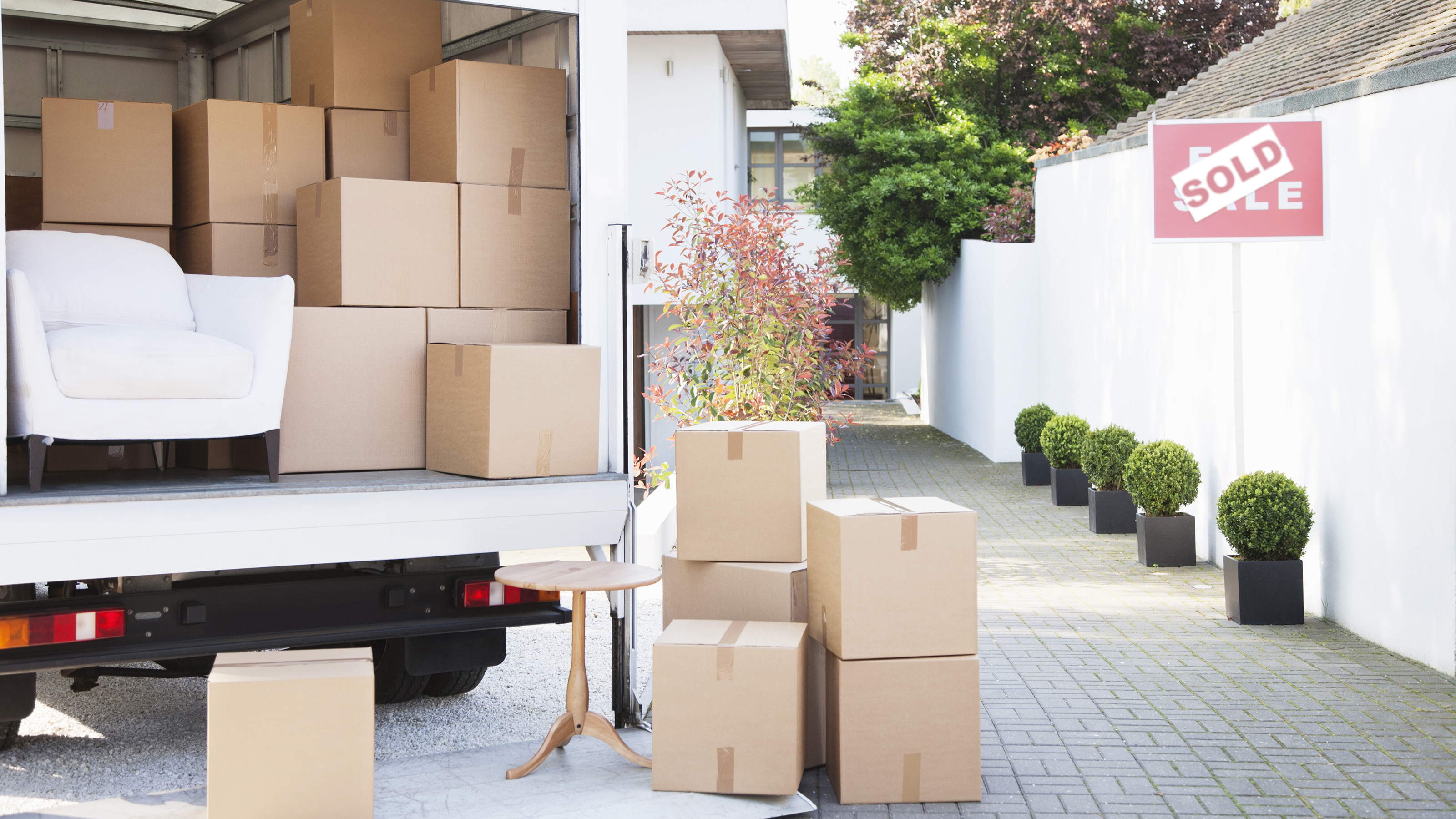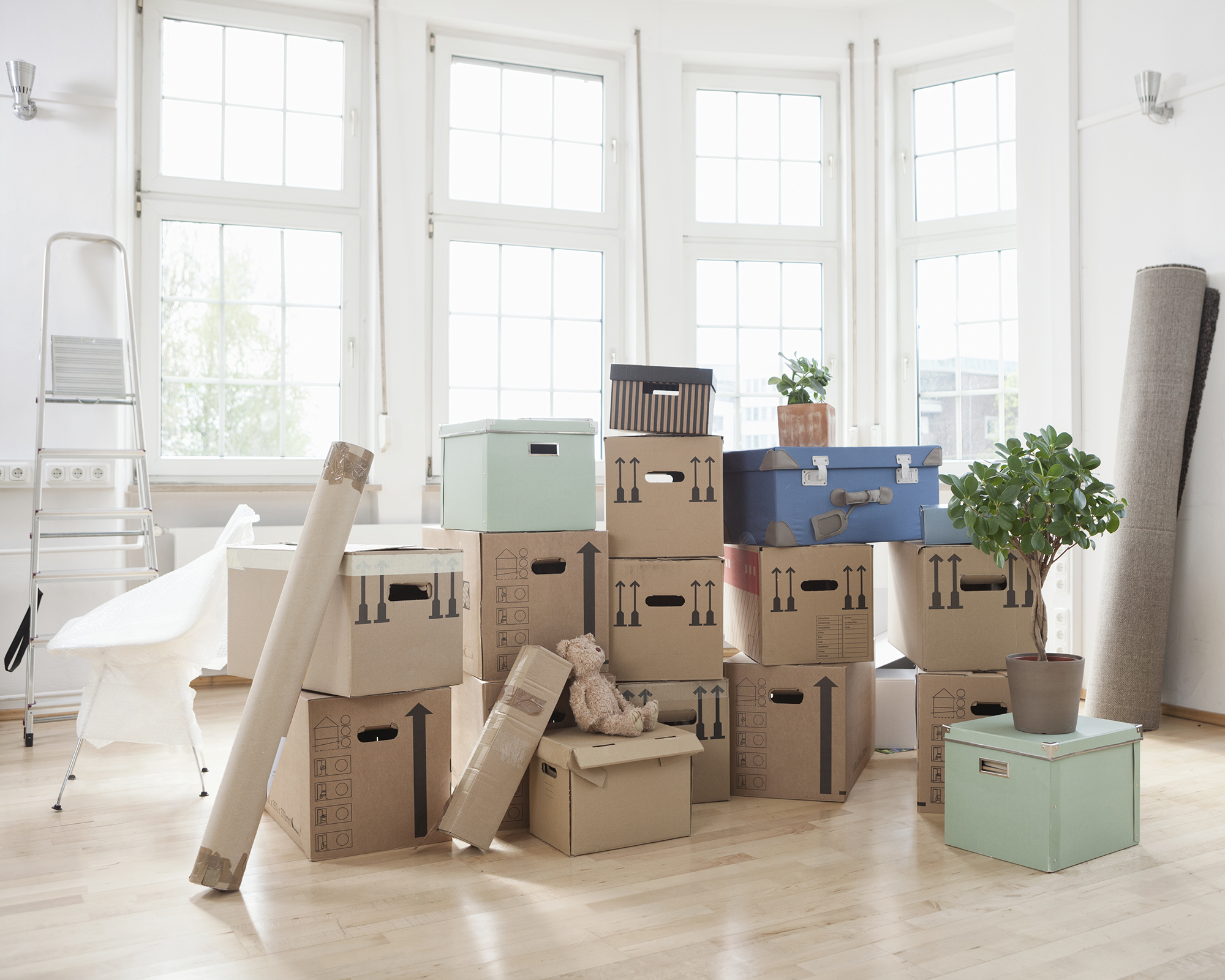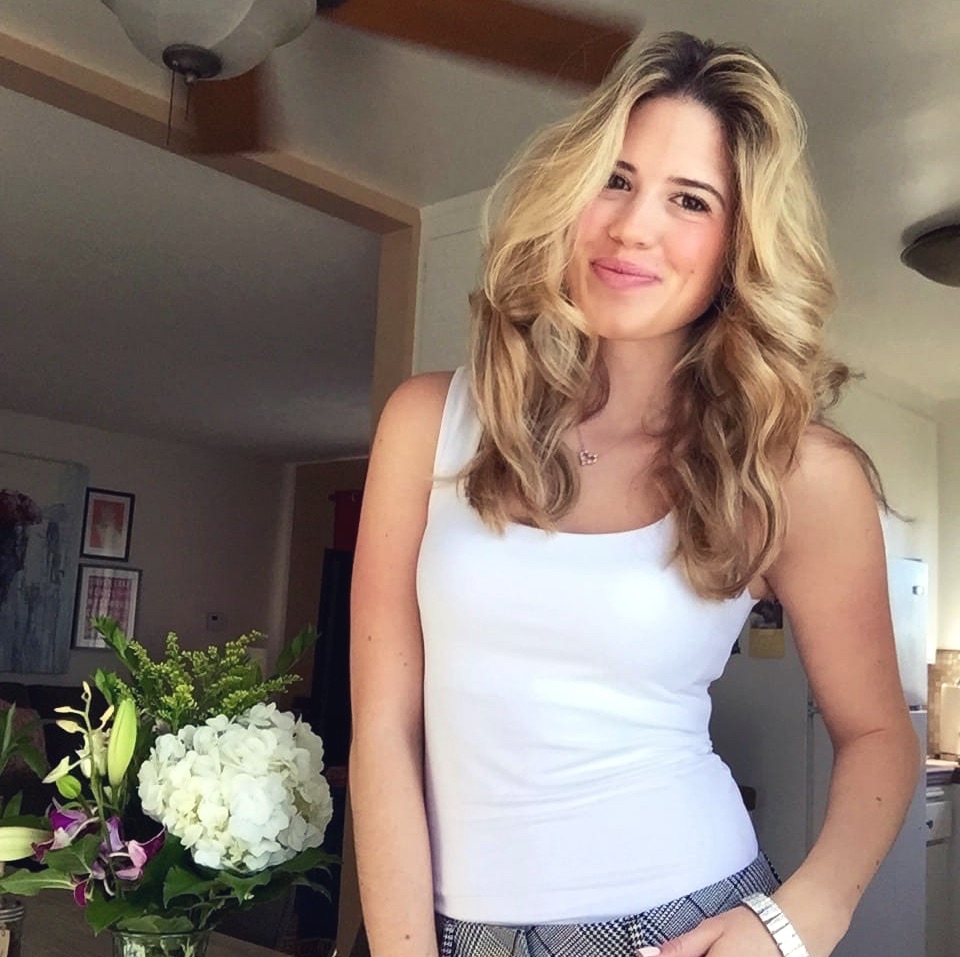How to pack for a move: a 15-step checklist for a smooth transition
If you're wondering how to pack for a move, these expert tips can make a typically stressful process much smoother


If you think you know how to pack for a move... Think again! We all think we're pros, that is until, it all goes to pot. Then it becomes super evident that actually packing to up sticks, is not just about popping your wares in cardboard boxes or tote bags and hoping for the best. Being efficient with your packing and planning process will get the job done more quickly, and you're less at risk of injuring yourself or breaking a prized possession.
Grandma's heirloom, for example, shouldn't be buried under miscellaneous items you've been meaning to get rid of from a previous move. Rather than crossing your fingers for things to arrive unscathed in transit, we've spoken to a handful of experts about the best ways to pack when moving house.
Our helpful house moving checklist starts with scaling back on the stuff you don't need and clear labeling so you know what you're carrying, and what container is suitable for shimmying your stuff.
How to pack when moving house
The aim of the game is to get your items moved safely and securely in as little time as possible — all without having to spend above and beyond your planned budget. Check everything off and you're sure to avoid the most common moving mistakes, much to your benefit, we assure you!
Packing essentials
1. Cardboard boxes: Try this 15-pack from Amazon
2. Brown packing tape: Go for the heavy-duty stuff
3. Scissors: These soft grip snippers make the cut
4. Biodegradable packing peanuts: cushion cups and crockery
1. Declutter first
Heading to a new house or moving into a new apartment are great times to assess what items are important to you, and what is just junk, so use this opportunity to free up space – especially if your new place is on the smaller side. If sorting through seems stressful, there are plenty of moving hacks out there to help you make the process easier. In ten steps, you can wade through unwanted items and potentially make some money in the process.
Emily Snape, growth director, LOVESPACE says: 'Before you start the packing, declutter. There’s no point taking things with you that you don’t need or want. If the items are in good condition, sell or donate to charity.'
If you don't need access to your commodities straightaway, review local storage options available to you, or see if your friends and family can stow things away in a spare room. Or hand down unwanted pieces that have significance. A late relative's set of fine China could be worth hundreds of dollars, so it makes sense to keep it in the family (for memories, or cashing it at a later date).
Christina Giaquinto, professional organizer and brand ambassador of Modular Closets adds: 'Ask yourself, 'do I want to bring this into my new home?' 'Is this useful for my new home?' 'Does this bring positive energy into my new home?' 'Does this hold meaning in my life?'
2. Plan what you'll pack
As cliche as it is, the old saying runs true: Fail to prepare, and prepare to fail.
Get small space home decor ideas, celeb inspiration, DIY tips and more, straight to your inbox!
'Something basic that people tend to forget is planning. Writing down details like the items that have to be packed and what box they are to be kept in, in a notebook or on phone can save a lot of stress.' says Colleen Colodany, CEO of Kids Wiki.
Doing this by room can help make this less overwhelming. And on that note...
3. Assess what you'll need to pack your possessions

Now is the time to calculate how many boxes, bags, and containers you'll need. Though it may seem smart to cram things into containers, based on the logic that fewer trips = saving money on fuel, don't assume that brimming your boxes will be the right route to take.
Items that spill out of cardboard boxes can get damaged, and scuff your new property walls. What's more, by attempting to lift extra heavy boxes, you could do yourself an injury. And while parcel tape is known for its strength – it's not invincible. Boxes can break, and items can drop on your feet, delaying your operation altogether. If some items are jaw-droppingly expensive or particularly sentimental, it's worth checking if your contents insurance covers accidental damage.
4. Select the right packing supplies
While we're on the subject of boxes, make sure you're able to source good-quality boxes in various sizes. There's no point relying on dog-eared and damp cartons in the garage. So try and prepare in advance by buying them from a warehouse, on Amazon, or see if your local cash and carry have any to offer for free. You could also try Facebook MarketPlace or Freecycle too.
'The first, and most important tip, for moving is selecting the right size and strength moving box. Rule of thumb when moving is that a full box should never weigh more than 50 lbs,' says Elle Nesher, owner at Element Moving. 'Plastic crates are also an eco-friendly alternative to moving boxes, and they tend to protect belongings better than cardboard.'
- 1.5 cubic foot boxes: Perfect for books, children’s toys, kitchen items, or small/medium-sized board games
- 3.0 cubic foot boxes: Larger boxes that are a good fit for electronics, pans, pots, and other larger household items
- 4.5 cubic foot boxes: Ideal for linens and folded clothing
- 6.0 cubic foot boxes: Pack your heavier bedding, artwork, or couch cushions in these boxes.
Self-seal sandwich bags, bubble wrap, packing peanuts, and old newspaper are staples when packing for moving. You can use the food pouches to keep loose flat pack furniture parts together, and air bubble packing will protect fragile items made of glass or ceramic (ie: your best statement vase or expensive dinnerware sets).
'You can use linen, bath towels, pillows as padding and wrapping for other items. Doing so will help you reduce the chances of damaging fragile belongings during transit. Stuff any empty space in boxes and between other packed goods to keep them from shifting in the box and bumping against one another.' advises Kate Hart, removals and relocation manager at Fantastic Removals.
Pillboxes make a great place for organizing necklaces, rings, bracelets, and other bits of jewelry that can get tangled or easily lost. Not all of them are designed with dates so this won't look like you're carrying medication, so needn't alarm anybody!
Oh, and investing in a good tape dispenser is key to keeping calm and avoiding sellotape sticking to itself (or you!)
5. Pack properly
Whether you've rounded up the relatives, or getting employing pros to move house, it pays to organize your boxes so that anyone can carry them with ease. This ultimately means distributing the weight in a way that is comfortable for the carrier in question.
'Pack heavier items on the bottom of the box and lighter items on top. This is so heavier items can act as a stabilizer for the rest of the cargo, which will help to prevent things from shifting around during transit and potentially causing damage.' says Meyr Aviv, founder, and CEO at iMoving.
6. Label with purpose
A sea of brown boxes in your living room is likely to be a bit overbearing to look at after a hard day of lifting and shifting. So make things easier for your future self by adding colored stickers or labels to quickly identify which room each box belongs in.
'During the packing process itself, I’ve found that color coding and labeling is the best way to go!' explains Hart.
'Choose a color to go for each room (ex. blue for the kitchen, red for the living room, etc.). Mark the boxes in which you have items from each room with their corresponding color.'
'You can write down on the box itself what it contains before closing it off for good. However, then there is the possibility during the relocation process those lists become damaged and hard to read. A good and helpful alternative is to simply add numbers to the boxes and do a detailed list of the contents of the box in a notebook you will keep on you.'
7. Don't do it all at once
The key to most organizational tasks is to take adequate breaks and refocus. It can be incredibly overwhelming having to pack for moving, just for yourself, let alone others.
So, when boxing up belongings, break the task down into bite-sized timeslots. By making a plan in advance, you can give yourself an hour at a time to sort through your property and anything that belongs to your dependents. Use the timer or stopwatch function on your smartphone to manage your time. A good Spotify playlist also helps to keep your energy up.
Ensure you pack based on what works best. There's no need to raid a whole room if you're only going to unpack these items a couple of days later. For example, while you'll have an idea of what you want to wear/need as D-day approaches, kids (and pets) can be unpredictable so it's best to keep on the side and pack their stuff last. Packing too early can be just as bad as leaving it until the last minute.
8. Keep an essentials box in close proximity
Moving into a new home can be super exciting. But sometimes we can get so caught up in packing decor and furniture that we forget about the things that we need to survive and function throughout the process of shifting articles.
Snape says: 'Pack a box with the essential items you’ll need the day of, and a few days after, the move. The kettle, tea, and coffee are good places to start – you'll want the caffeine. Include any important valuables, a phone charger, extension leads, cleaning supplies, and toilet roll.'
Since all that packing and moving can work up quite the appetite, it's worth having a microwave and a toaster to hand, so that you can make food quickly when you need it.
The likelihood is that the first couple of days are going to be spent calling suppliers (and patiently waiting in phone queues) so a fully-juiced cellphone, ample supply of caffeine, and perhaps a dongle (for the internet) are essential. You can grab this small electronic device from your phone supplier.
9. Plan for your arrival
If you know how to rent, you can expect that while end-of-tenancy cleans are required to ready you up as a new tenant, some rooms might not be quite up to your standards. So it's always worth coming armed with some of the best cleaning products – air freshener included! Just be sure to pack these away from items you're particularly precious about as bleach, aerosols, and corrosive solvents can be damaging. We know it's not exactly eco-friendly, but using clingfilm/plastic wrap can save you from distress.
And, if the electricity supply hasn't kicked in just yet, get yourself some candles. These don't need to be your best scented candles (do not burn your Jo Malones). Instead, a few cheap wax lights or battery-operated faux options will suffice.
10. Don't forget to pack for your pets

Cats and dogs can be super territorial. If you've lived in your family home for a long time, moving can be super stressful. You may want to pack a few extra treats, invest in some puppy pads while they get used to a new toileting spot, and plug in a Feliway diffuser to keep them calm.
Refrain from packing the pet bed away, as this can be used in the car and immediately laid on the floor to give them some reassurance and comfort in the new environment.
Speaking on her first-hand experience, Jacquelyn Kennedy, founder, and owner, PetDT says: 'With my dogs, specifically, I packed their blankets, toys, and pet beds so that they were on hand, and it was the first thing I placed down before I let them inside to explore the new house. I think that finding those familiar items of comfort reassures them that this new space is a safe space and that it is their territory, so to speak.'
11. Keep hold of your critical documents
Though digital docs are good for referring to on the go, it's sensible to have hard copies at hand. And, even if you do have electronic versions of forms and contracts, if you don't have a phone or laptop charger – you won't be able to access them.
'Pack a separate bag for your important documents.' insists Meyr Aviv, founder, and CEO of iMoving
'This includes things like your passport, birth certificate, social security card, and any other important papers. Having them in a safe and easily accessible place will help to prevent any stressful situations. You can also buy a tracker like the Apple AirTag to put in this bag so you can easily find it if it gets misplaced.'
12. Work out how you're getting stuff to the new house
Whether you're using a car, or hiring a man and a van, unless you're moving next door, you'll need some mode of transportation. But there's a huge difference between rounding up a bunch of friends, and getting a professional moving company to do the job for you.
The first (significant) factor is what it costs to move house. While your mates might do the job for a mere beer or two, but this won't wash with the pros. Expect strict rules for expert movers as they'll need to cover their backs. Some might only drop stuff at the door, and many companies will charge for unpacking inside the house, so it's best to read the small print to see what the service includes. Time is money for these organizations, so try to limit them from waiting around by having everything securely packaged and ready to be popped into the van.
'Hiring a professional moving company will ensure that your belongings are handled with care and that your move is as stress-free as possible,' says Aviv.
'Professional movers have the experience and expertise to handle every aspect of your move, from packing and loading to transport and delivery. It's also important to compare mover quotes to ensure you're getting the best deal. Check out estimates from several different movers, and be sure to ask about all of the associated costs, such as packing and unpacking fees.'
On the contrary, if you just need a vehicle, it may be cheaper to look into self-drive van hire. In London, you could use Zipvan who are available in USA, Canada, the U.K and other select countries. The cost is based on an hourly rate, and gas is included.
13. Consider packing couch legs and cushions separately
Contouring couches through hallways and doors is no fun, and unless you and your packing partner have been pumping iron lately, it's hard work. When looking at how to pack for moving, you might also want to consider dismantling any furniture and reassembling it on the other side.
Sofa legs and cushions can be removed so that you can just focus on getting the frame through tight spaces.
14. Clear out perishable items on your last day
If you're moving out of a rental, while not absolutely necessary, it is courteous to empty and clean the fridge if the appliance was part of your rental agreement. Sure this tip isn't part of a true packing protocol, but by reviewing the contents, you could save yourself stopping at the supermarket for fresh food. On the week of your move, manage expectations with the family that you intend on running down the refrigerator, so meals may have to be on the frugal side!
Put anything past its use-by date in the trash and make sure you've got a cool bag on hand to save any chilled goods and leftovers stowed away in the freezer.
15. Assess your loading logistics
Whether you're using the family car or a large van to help along the moving process, be intentional around the order of the things you move.
'Load the truck in a certain manner so that unloading it is seamless. We tend to load the bigger items like beds and tables last because when we get back to our storage locker or the next house we want to unload those first so they're out of the way,' says Doug Greene, owner at Signature Properties.
'Another great thing to remember is that you should always start early. If you try to get up, go out, rent a truck and come back to start moving by lunch then you probably shouldn't expect to finish unloading the truck that same day. We like to get the truck the night before, maybe even pack up a few difficult items, and then start fresh in the morning,'
'This way we can maximize the first few hours before it gets too hot outside and be en route to the next destination in the early afternoon. This lets us get it all done in one day!'
How long before a move should you start packing?
'Everyone knows you are moving, you don’t need your nicest dinnerware or your collection of antique stuffed animals accessible for the last month you are in your home,' says Elena Zimmerman, content writer, Love & Lavender.
'Start packing up one to two months before the actual move. Pack up the bread maker you only use on holidays, the clothes you wear in the opposite season of whatever it is now, the super fancy Crystal glasses you rarely let guests touch.'
'Pack 2 -3 boxes with plenty of bubble wrap or newspaper into easily stackable boxes and make sure they are taped securely and labeled well. Also label that this is a second unpack, not first (you will want to unpack a frying pan in your new place before the tile caulk!).'
'Continue packing 1-2 boxes a week after work or on the weekends until about two weeks before your move. Depending on how much you have, up this to a box a day until three days before your move. On the third day before moving, pack everything left besides essentials for a few days. On the day before the move, begin disassembling all furniture except for your bed. If desired, you can even unbuild this and sleep on the mattress. This may seem like a lot of prep in advance, but it will save your sanity in the long run.'
And, Mallory Micetich, home Expert at Angi agrees that less frequently-used items should be boxed up at the beginning. They say: 'Start by packing items you don’t use often, like out-of-season clothes, holiday decorations, guest room decor, books, and collectibles. As you get closer to your move date, you can start packing up the items that you use more often.'
How do you move a TV without breaking it?
We spoke to Kevin Walmsley, TV expert at AO who gave us his 3-part guide on how to pack your best TV when moving home:
- Pack up your wires: Unplug the power cable, any satellite cables and any leads for accessories such as sound bars or games consoles. An easy way to keep track of which wire is for what is to put them in a labeled sandwich bag or tie them up with a cable tie and attach a sticky label.
- Pack up any extras: Wrap up any consoles or accessories in bubble wrap or something soft like an old blanket so that they don’t move around in the box and break.
- Securely pack up the TV: Give your TV a quick wipe down and then remove it from its mount/stand. Wrap it up in bubble wrap or corrugated cardboard and pop it back inside its original box (if you still have it). If you don’t, you can order a box online for relatively cheap that will fit your TV You can also just wrap it up well with the protective material of your choice, put cardboard, corner protectors, on it, and then wrap it in cling film to make sure everything stays together nice and snug Make sure to attach some ‘FRAGILE’ stickers so that the removal team will know to be extra careful when moving it
Meet the packing experts

Expert lifestyle organizer, Christina Giaquinto believes your best and happiest life can be achieved by getting organized. After realizing her love for color coordinating, creating binders, and de-cluttering was not considered fun by most people; she knew she had a slight (more like massive) obsession with organizing. She believes an organized life is a necessity and not a luxury, and it is her mission to help as many people as possible incorporate this life philosophy. Her greatest joy is seeing the transformation her clients experience!
She runs a very successful home organizing business in New Jersey, and privately coaches clients one on one to organize their life. Her philosophy teaches others to de-clutter so one can fill their lives with nothing but beautiful and meaningful things. She loves meeting new people and you can always find her smiling with a cappuccino in hand!

Elle Nesher is the co-owner of Element Moving and Storage LLC based in Dallas, TX. Her unparalleled dedication to customer service has fueled exponential company growth for the past decade. She believes that moving companies should treat their customers as more than just a number. As a result, she has earned a solid brand reputation evidenced by a high volume of referrals and repeat business.

Meyr Aviv is an expert in the moving and relocation industry, starting his career in New York City in the late 1990's. He built his career on providing exceptional service and harnessing his knowledge and experience in moving logistics to become a key player in the moving market. Meyr established an independent moving company and a successful brokering service while gaining nationwide experience in local and long-distance operations. He's on a mission to connect all stakeholders in the moving ecosystem via iMoving.com, and he's aspired to set new standards for the moving industry that support transparency and agility using advanced tools and technology.

Doug Greene is the owner and operator of Signature Properties in Philadelphia. He created his business to help homeowners in the state sell their houses without feeling overwhelmed or taken advantage of.
He has lived in Philly for over a decade and knows exactly what local homeowners are looking for when they want to sell their homes. Together with his team, he buys any kind of property whether it is distressing, old, new, or even ready for the bulldozer!

Mallory Micetich is a home care expert, with particular expertise in small home living and consumer protection. While currently renting in Denver, CO, she has been a homeowner, investor, landlord, and renter over the last decade.
She is committed to minimizing her environmental footprint and to small home living, having lived in only properties of 1,000 square feet or less. Mallory is currently the VP of Corporate Communications at Angi, where she focuses on bringing awareness to Angi and what we do every day to help homeowners love where they live.

Jacquelyn Kennedy is a canine behavioral specialist, professional dog trainer, and the founder and CEO of PetDT. She created PetDT to provide dog owners with a readily accessible archive of breed-specific information and experience and to act as a go-to guide to canine health, nutrition, care, and more.

Having worked in the removals niche for so many years now Kate finds much more time to write advice articles suitable for home movers, students' accommodation (moving to university), tenants seeking to get their security deposit back, first-time buyers, and house sellers alike.
These days she's a proud mother of two young children which makes it difficult for her to do what she's used to. However, she soon figured out a way to continue helping people move houses or businesses by sharing knowledge and expertise in the form of guides and insightful advice articles.

Hi, I'm the former acting head ecommerce editor at Real Homes. Prior to working for the Future plc family, I've worked on a number of consumer events including the Ideal Home Show, Grand Designs Live, and Good Homes Magazine. With a first class degree from Keele University, and a plethora of experience in digital marketing, editorial, and social media, I have an eye for what should be in your shopping basket and have gone through the internal customer advisor accreditation process.